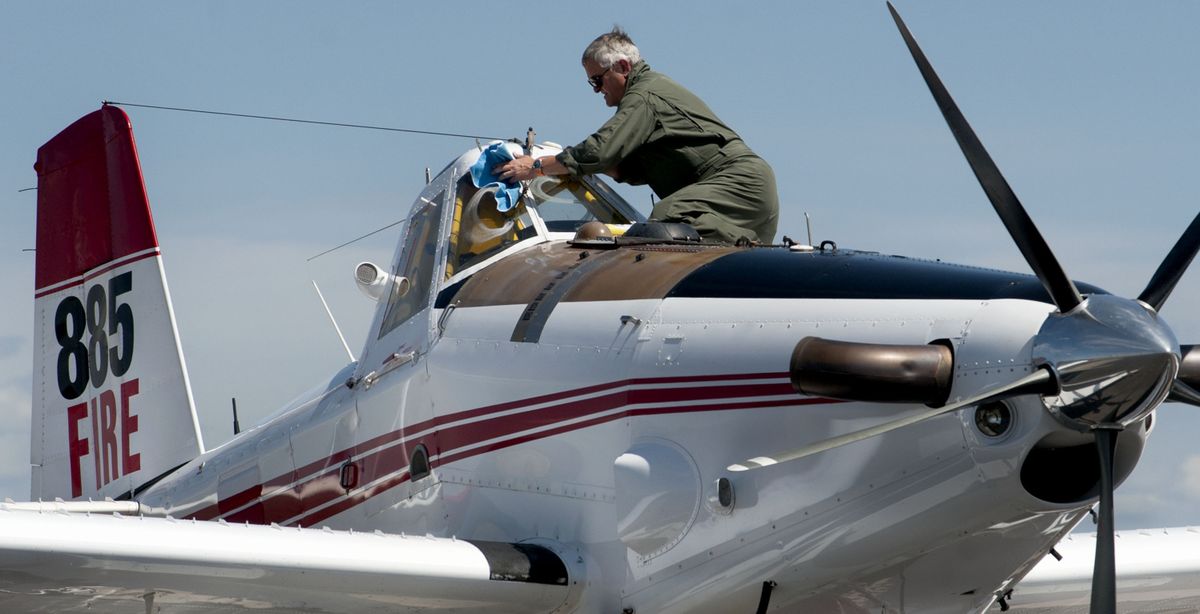An early, hot season stretches resources at Coeur d’Alene Wildland Fire Center

Don MacDonald scrubbed down the windshield of his plane as it refueled at the Coeur d’Alene Interagency Wildland Fire Center last week, rinsing off bugs and smoke residue.
Shortly afterward, the “Fire Boss” Air Tractor was back in the air.
MacDonald was headed to Hayden Lake, where the amphibious plane would suck up 800 gallons of water. His next stop was the Elevator fire, burning at the southern end of Idaho Panhandle National Forests, where he would empty his load over the blaze.
It’s been a busy stretch for the Bellingham pilot, who arrived in Coeur d’Alene in late June.
“There were three quiet days after I arrived – and then this,” he said.
Fire season is running at least a month ahead of schedule in the Northern Rockies, with drought-stressed forests hitting flammability levels not typically seen until late August. The interagency fire center, which dispatches firefighters and equipment, is feeling the heat.
More than 170 wildfires have been reported in the Idaho Panhandle this year, about half of them human-caused. Quick suppression efforts have stopped most of the fires at a few acres.
“The public has no idea how much fire we fight,” said Jason Kirchner, a U.S. Forest Service spokesman. Only a few turn into major fires like the Cape Horn fire near Bayview, which burned six homes and forced an evacuation of a rural neighborhood in early July. In most instances, “we’ve got firefighters stomping the fires out as soon as they’re reported,” Kirchner said.
The rapid response starts at the interagency center, which operates out of a low-slung building at the Coeur d’Alene Airport-Pappy Boyington Field in Hayden.
A team of 14 dispatchers takes reports of wildfires around the clock. Most reports come from 911 calls, but some fires are detected from lookouts or by commercial airline pilots, who radio the locations to the nearest Federal Aviation Administration tower.
The center serves a geographic area that stretches from the Canadian border to the Clearwater River, spanning millions of acres of federal, state and tribal lands. Dispatchers work with the different jurisdictions to assign crews and equipment to fires. The center also serves as an air tanker depot for the planes that drop water and retardant.
The Elevator fire was reported Wednesday evening from a fire lookout, which spotted smoke from the blaze about 10 miles south of Avery, Idaho. By Thursday morning, a Hotshot firefighting crew from Flagstaff, Arizona, was working the fire, along with an engine crew and the air tankers dropping water and retardant. The fire’s cause remains unknown.
Fast attacks are particularly important this year. North Idaho forests are the driest they’ve been since the 1950s, with the potential for extreme fire behavior. Extra resources have been channeled into the region to knock down the fires early, Kirchner said.
As of late last week, 20 aircraft, 43 engines and 200 firefighters had been assigned to North Idaho for initial attacks.
Bud McConnaughey has worked 41 fire seasons on the Idaho Panhandle National Forests. This is the highest level of preparedness he’s ever seen.
“This year has the potential to produce the once-in-a-century event,” said McConnaughey, an aviation officer at the interagency center. “It could be our 1910 fire of the 21st century.”
The 1910 fire is still recognized as the largest wildfire in U.S. history, burning 3 million acres across northeast Washington, North Idaho and Western Montana.
Wildfires have burned about 1,800 acres in the Idaho Panhandle this year. The fires started in spring, with early reports of yard-debris piles blazing out of control.
People simply don’t comprehend how dry it is, said Kirchner, the Forest Service spokesman. They’re used to burning a pile of branches in their yard, or having a campfire this time of year. Some have questioned the agencies’ widespread bans on campfires and wood-cutting restrictions in the woods, referring to the restrictions as “government overreach.”
“We don’t go into restrictions unless we’re in a bad spot and we really need them,” Kirchner said. “They’re difficult to enforce and unpopular.”
Of the 171 wildfires reported in the Panhandle through last week, 89 have been human-caused. With firefighting resources in high demand across the West, human-caused fires create an additional burden.
“That’s 89 times when we had a firefighter out fighting a preventable fire,” Kirchner said, “which means they’re unavailable when a lightning fire pops up.”